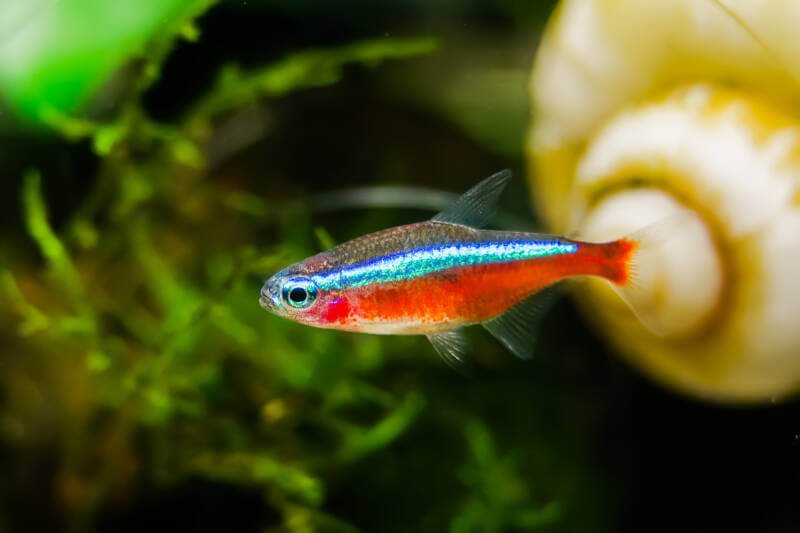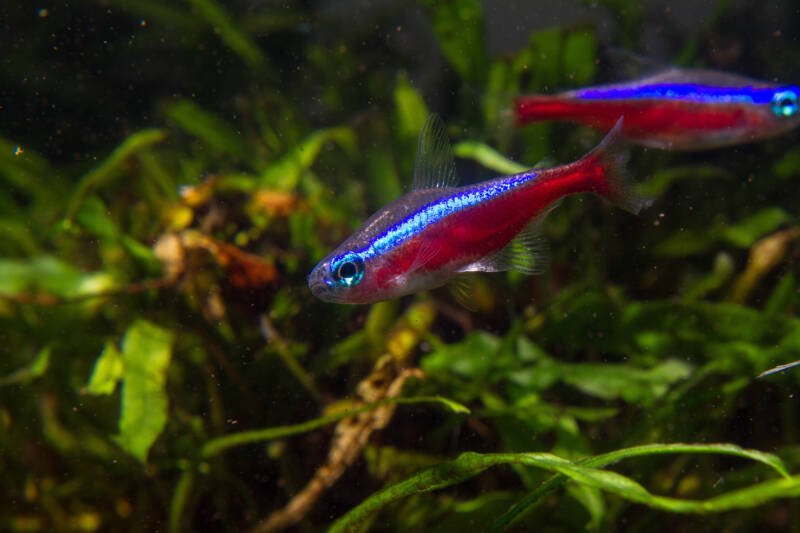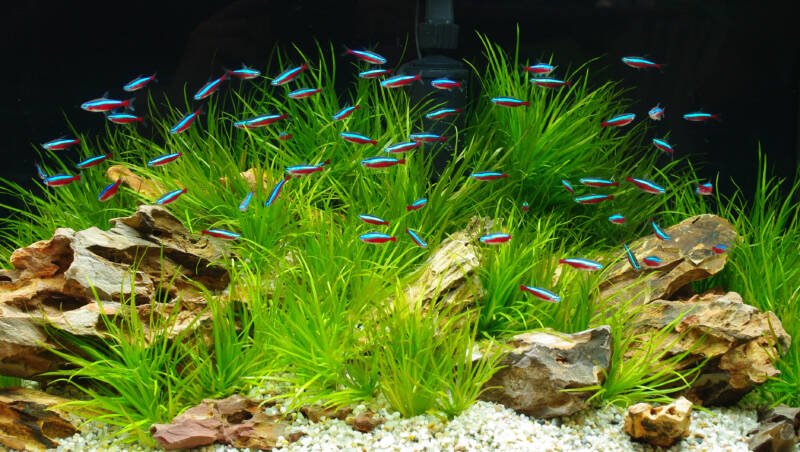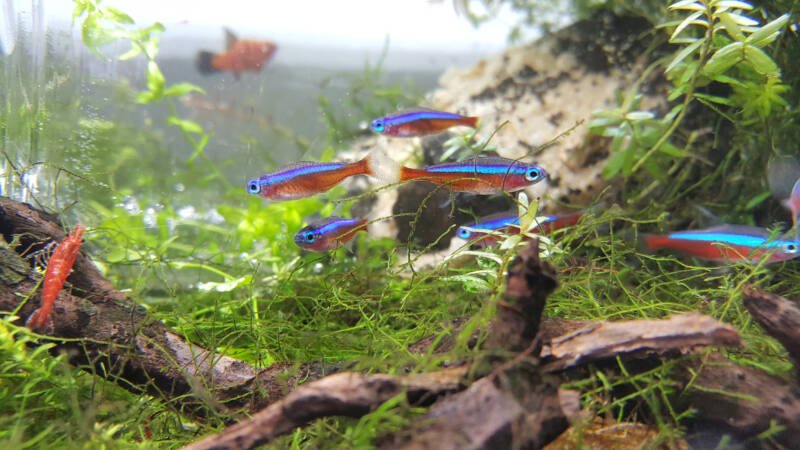Have you ever considered adding a school of cardinal tetras to your aquarium? These vibrant fish are a favorite among aquarists for good reason.
With their stunning colors, peaceful demeanor, and hardiness, they are a staple for both novice and seasoned hobbyists alike.

Cardinal tetras can be found in aquariums all over the world. Not only are they commercially available, but they’re also a frequent feature in hobbyist forums and magazines.
And if you’re into aquascaping, you’ll be thrilled to know that cardinal tetras make for excellent showcase fish.
So why not add some cardinal tetras to your aquarium today? With their versatility and adaptability, these fish are sure to bring joy and beauty to any setup.
At a glance
| Minimum Tank Size: | 15 gallons (60 l) |
| School Size: | at least 5, more is better |
| Temperature: | 73-81°F (23-27°C) |
| Lifespan: | up to 4 years |
| Size: | 2 inches (5 cm) |
| pH: | 5.5-7.5 |
| Hardness: | 2-6 dKH |
| Ammonia: | <2 ppm |
| Nitrite: | <2 ppm |
| Nitrate: | <2 ppm |
In this article
Physical Description, Sexing, Size, & Lifespan
The cardinal tetra (Paracheirodon axelrodi) is perhaps one of the most distinct and easily recognizable fish in the aquatic industry.
Its body is bisected into thirds by stripes. The top line is a dark grey, the middle is a striking blue stripe, and the bottom is a bright red stripe.
The blue is nearly growing in its intensity and is very luminescent.

Its fins are translucent and short, stuck close to its body, and shaped practically for fast swimming.
To tell the differences between male and female cardinal fish, look for a hook protruding from the anal fin. Male tetra also tend to have a slimmer/ leaner body and a less round stomach.
Because of its coloring, the cardinal tetra is often mistaken for the neon tetra.

However, the neon tetra does not have distinctive stripes running parallel down its body.
Instead, the bottom half of the fish is split between a white section (near its eye) and a red section (near its anal fins). The cardinal tetra has no white at all on it.
Additionally, the neon’s tetras bright blue stripe is located along its top or middle.
The cardinal tetra only grows up to 2” in size and only lives an average of four years. Some have reported their fish living past this four-year mark.
Behavior
This fish is one of the most peaceful types of tetra.
They are suitable for species-only tanks but make a beautiful statement in a community aquarium.
And since community aquariums tend to be of a larger gallon size, tetras especially thrive in these environments.

Cardinal tetras prefer to swim in the middle and top layers of the tank. They enjoy having lots of open swimming space.b
But they definitely also appreciate having lots of plants to rest, explore, and mate in.
These tetras have a high activity level and are almost always on the go. This may disturb any shy inhabitants, such as gourami.
However, depending on the type of community aquarium you set up, this may be the natural behavior for all of the tank inhabitants.
Natural Habitat
Cardinal tetra are native to South America. There, schools of this species inhabit slow-moving and well-vegetated waters.
Tributaries and rivers are commons places to find them.

They also prefer shaded areas that have low or subdued lighting.
Their preference for these conditions has carried over into the aquarium hobby, despite cardinal tetra now being captive bred.
There is a significant amount of vegetation in these tributaries and other bodies of water.
Because of that, it’s recommended to keep live plants in the aquarium too. It will allow the tetra to explore, get away from each other, and mate if they need it.
Tank Setup
This schooling fish needs an aquarium of at least 20 gallons. Larger schools and community tanks will require at least double that gallon size.
Long rather than tall aquariums are always better for this fish, as the cardinal tetra appreciates having room to roam and explore.
Equipment & Environment Setup
There are very few pieces of equipment that are needed to replicate the original habitat of the cardinal tetras.
Most of it will depend on the decision of whether or not to include live plants in the aquarium.

- Filtration: Cardinal tetra prefer waters that don’t have a lot of currents, so many filters may be too powerful. Consider an internal filtration system or an undergravel filter to prevent water from being too fast.
- Heating: The water should be kept warm since the cardinal tetras is a tropical plant. A thermometer is also highly recommended to make sure the water is warm enough for the inhabitants.
- Lighting: If you include live plants in your aquarium, make sure the lighting you invest in is plant-grade and at least 4500K. And since these tetra prefer low to moderate lighting, an adjustable system is recommended.
- Substrate: Similar to lighting, if you put real plants in the tank, you’ll need a plant-safe substrate. Look for one that is long-lasting and has all the nutrients your plants will need, even in the future.
Lighting and substrate are likely to be the most expensive components of setting up an aquarium to house cardinal tetra. However, there are plenty of options available on the market that fit everyone’s budget and work well.
Water Parameters & Preferences
The cardinal tetra is a fairly hardy fish that does well for beginners and is very forgiving in terms of water quality and parameters.

That being said, there are specific temperatures and water ranges that it prefers.
- Temperature: This tropical fish does best when housed in water that’s been warmed to 73–81° F. However, it can stand a few degrees variation from this in terms of colder water (not hotter water).
- pH Range: The cardinal tetra can stand a pH range that is neutral or slightly acidic. Water that is between 5.5 – 7.5 pH is perfectly acceptable. But like the temperature, some variation can be forgiven.
- Hardness: A water hardness of anywhere in the range of 2 – 6 KH will still allow these tetras to thrive. Aquarists have some leeway with the water hardness, but not overly much past 8 KH.
Though not enjoyable, the cardinal tetra can handle ammonia, nitrite, and nitrate levels of up to 2 ppm.
Some aquarists have even reported level as high as 5 ppm with no loss of life within cardinal tetra schools. However, testing this experiment isn’t recommended.
Weekly water changes are an absolute must, even if you keep these tetras in a species-specific tank.
Tank Mates and Compatibility
As mentioned earlier, cardinal tetras are extremely friendly. Schools do fine in species-only tanks, but they must prefer being around other tank mates.

These tetra can live peacefully with many different types of fish, including:
- Other tetras, such as the neon tetra
- Danios, guppies, and rasboras
- Dwarf and opaline gouramis
- Some catfish species members
- “Clean-up” crew like snails
It’s best to keep them with other fish that are also docile and have peaceful temperaments. Avoid fish that are known to bully (and worse, eat) smaller fish.
To avoid this temptation altogether, many aquarists keep cardinal tetras with other small schooling fish that can’t fit the cardinals in their mouths.
Food and Diet
Cardinal tetras are not picky eaters and will accept most of what you put in the tank during meal times.
They will avidly eat frozen, freeze-dried, and even live food when the desire strikes them.
In general, they prefer meatier foods. Depending on the food, the pieces may need to be broken up before feeding time.
- Brine shrimp
- Daphnia
- Tubifex
- Bloodworms
And, of course, flake food and pellet food will also be gobbled up in a matter of seconds. This is especially the case with community aquariums.
You should feed cardinal tetras (and other inhabitants) only as much as they can eat within three minutes.
Aquarists should provide meal times at least once per day.
If you notice their stomachs bulging, stop feeding them. Slight distension is normal, but anything past that is a sign of overeating.
Breeding

To tempt cardinal tetras to breed, you must once again mimic their natural habitat and alter the water conditions.
If you follow the steps below, your tetras will hopefully begin laying eggs soon.
- Keep the temperature steady
- Change the pH to 5 – 6
- Adjust the KH to 1 – 2
To achieve these parameters without disturbing other fish parents, a separate breeding tank is almost always set up.
If the male and female cardinal are successful and fertilize the eggs, the female will begin spawning and laying as many as 500 eggs.
Once the eggs are laid, the parents should be removed from the breeding tank, or the aquarist should set up a temporary tank and place the eggs in there to prevent the parents from eating them.
Within 24 hours, the eggs will hatch. Within the week, they’ll be waterborne and independent.
Baby brine shrimp and infusoria are just two examples of what you can feed them during pregnancy and sexual intercourse.
However, it’s also important not to focus too much on breeding. Cardinal tetras are not impossible to breed in captivity, but it is significantly more difficult to tempt them.
Reasons to Get Cardinal Tetra
There are many practical reasons to buy cardinal tetra.
They are simple to care for, impress all onlookers, and are very hardy in terms of water conditions.
Beyond this, their inquisitive and energetic disposition makes them a treat to watch as they roam all over the tank and interact with the other community inhabitants.
They also show beautiful colors that are only enhanced when placed in a proper school.
As they flit about the aquarium, they resemble small red and white firecrackers.
Fortunately, the beauty of cardinal tetras lasts significantly longer than that of fireworks.